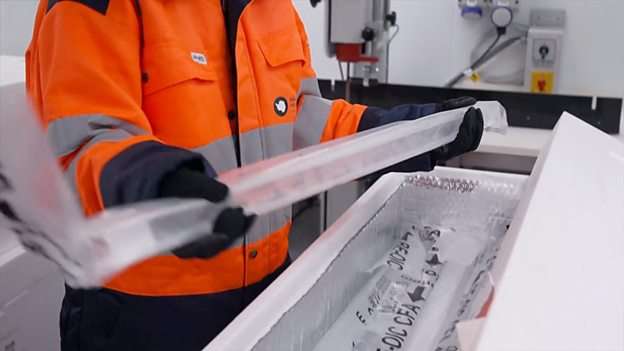本集内容
UK scientists to examine the world's oldest ice sample
英国科学家将仔细研究世界上最古老的冰层样本
文字稿
Extracted from deep beneath Antarctica, a core of ice – the oldest that's ever been collected. And it holds a unique record going back more than a million years.
这是一块从南极洲地下深处提取出来的冰芯,并且是人类钻取到的最古老的冰芯。这条冰芯中包含了一份独特的历史记录,足以追溯到一百多万年前。
Dr Liz Thomas, Head of the Ice Cores team, British Antarctic Survey
"OK, come on in. I'll switch the lights on."
莉兹·托马斯博士 英国南极调查局冰芯团队负责人
“好了,进来吧。我来把灯打开。”
Now, the ancient ice has arrived at the British Antarctic Survey (BAS) in Cambridge.
现在,这些古老的冰抵达了位于剑桥的英国南极调查局。
Dr Liz Thomas, Head of the Ice Cores team, British Antarctic Survey
"So these are the boxes."
莉兹·托马斯博士 英国南极调查局冰芯团队负责人
“这些就是装有样本的箱子。”
There are 190 pieces, each a metre long.
一共有 190 条冰芯,每条有一米长。
Dr Liz Thomas, Head of the Ice Cores team, British Antarctic Survey
"I'm going to do it very, very carefully."
莉兹·托马斯博士 英国南极调查局冰芯团队负责人
“我要非常非常小心地处理这条冰芯。”
Kept at minus 23 degrees in the freezer.
这些冰芯被保存在零下 23 度的冰柜中。
Dr Liz Thomas, Head of the Ice Cores team, British Antarctic Survey
"This is the most precious sample, because what we've actually got out on the bench in front of us is the oldest ever ice core. So we're hoping that this record is going to actually go back at least 1.2 million years, hopefully 1.5, but it could actually be even older."
莉兹·托马斯博士 英国南极调查局冰芯团队负责人
“这是最宝贵的样本,因为摆在我们面前工作台上的是最古老的冰芯。我们希望这条冰芯的记录能追溯到至少 120 万年前,最好能有 150 万年,但它也可能更古老。”
The scientists set up camp in East Antarctica, drilling the ice cores from a depth of 2.8 kilometres over a period of four years. It needed painstaking precision.
科学家们在东部南极洲设立了营地,从地下 2.8 公里的深度钻取冰芯,钻取工作花费了四年时间。这项工作需要极度的精准。
James Veale, Ice core drilling engineer, British Antarctic Survey
"If you drill too fast, too aggressively, the core can get fractured into little pieces, which then makes it very hard and sometimes impossible to analyse properly in the labs here in the UK. But if you go too slowly, you miss your targets. You might then need a whole another season of drilling to reach the bedrock and reach the oldest ice."
詹姆斯·威尔 英国南极调查局冰芯钻取工程师
“如果你钻得太快、太猛,冰芯就会碎裂成小块,这会让分析工作变得非常艰难,甚至无法在英国的实验室里进行准确的分析。但如果你钻得太慢,又会错过钻取的目标。然后,你可能需要多钻一整个季度才能到达基岩和最古老的冰层。”
Rebecca Morelle, BBC correspondent
"The only way you can find out what's in this ice is to melt it. This piece here contains about 20,000 years of history. So by melting it incredibly slowly, millimetre by millimetre, you can find out how the world was changing over time."
瑞贝卡·莫瑞尔 BBC 通讯员
“要想知道这条冰里有什么的唯一方式就是将它融化。这条冰拥有大约两万年的历史。通过非常缓慢地、一毫米一毫米地融化这条冰,我们就能知道当时的世界如何随着时间所改变。”
The ice will reveal variations in temperature, snowfall, and even wind patterns. The tiny bubbles inside give a snapshot of the carbon dioxide levels.
这些冰可以揭示温度、降雪,甚至风向模式的历史变化。冰里面微小的气泡可以提供二氧化碳水平的简况。
Working from the youngest ice to the very oldest will reconstruct the Earth's climate history and help scientists understand the changes we're seeing today.
按照从新到旧的顺序融化研究这些冰可以重建地球的气候历史,从而帮助科学家们理解我们如今正在看到的气候变化。
Dr Liz Thomas, Head of the Ice Cores team, British Antarctic Survey
"The concentration of greenhouse gases in our atmosphere today are higher than at any time in the last 800,000 years, so we know we're in an unusual climate period. We want to understand how the climate is going to change in the future, and essentially as much information as we can provide about how the climate has changed in the past is going to improve our predictions."
莉兹·托马斯博士 英国南极调查局冰芯团队负责人
“温室气体在如今地球大气层中的浓度比过去 80 万年间的任何时候都高,所以我们知道人类正经历一段异常的气候时期。我们想了解气候在未来将如何变化,并且最重要的是提供尽量多的有关于过去气候如何变化的信息能够帮助我们提高预测的准确性。”
It will take about seven weeks to melt and study the precious samples. Once they're gone, they're gone.
融化并研究这些珍贵的样本将花费大约七周时间。这些样本一旦融化就一去不复返了。
But it's a chance to unlock the deepest secrets held in Antarctica's ancient ice.
但这是一个解开南极洲古老寒冰中蕴藏最深的秘密的机会。

